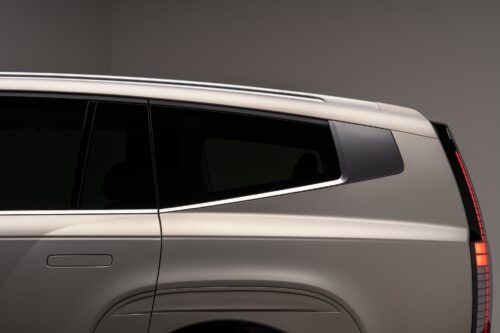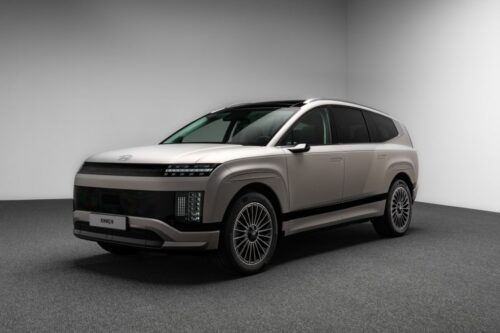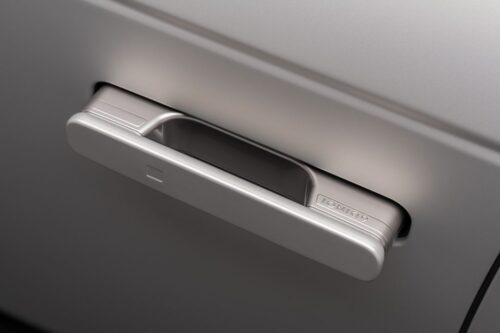Hyundai’s latest electric SUV seamlessly blends spaciousness, comfort, and modern sustainability with a striking design. At the world premiere of the IONIQ 9 in Los Angeles, Chapter spoke with the responsible design team to gain insights into the concept behind Hyundai’s largest electric vehicle to date.
As one of the most famous mid-century masterpieces in Los Angeles, the Sheats-Goldstein Residence designed by John Lautner is considered an architectural icon and has been the setting for countless film and music video productions. And if Hyundai has its way, its new electric SUV will also be iconic. It was therefore an obvious choice to use this architectural jewel in Benedict Canyon as a spectacular stage for the world premiere of the IONIQ 9. And as we all know, goals should be set ambitiously.

»Aerosthetic«—is Hyundai’s very elegant neologism for the design concept, which aims to harmonize aerodynamics and aesthetics as much as possible and which the IONIQ 9 now presented is intended to reflect in a very special way. »We did not design a typical large SUV, but an Aerosthetic Lounge, with a seamless blend of remarkable aerodynamic performance and refined design«, emphasizes SangYup Lee, Head of Hyundai and Genesis Global Design. And this approach is particularly evident in the harmoniously curved roofline, which sinks elegantly towards the rear to end in a strikingly sharp drop reminiscent of a classic boat stern. This silhouette not only gives the IONIQ 9 impressive efficiency in terms of aerodynamic drag, but also a remarkable dynamic elegance and distinctiveness that is often lacking in many other vehicles.

»If you look at the car from the side, the roofline is very unique. It’s a fast line as we call it, very swung back, and the rear of the car is chopped— almost like a 90-degree chop. And when you analyze aerodynamics, this is the ideal shape to get the most range out of a car. But at the same time customers also want a large interior. So achieving this ideal balance was quite a demanding aspect of the design process«, Kevin Kang, Head of Interior Design at Hyundai Design North America, also reports on the challenges involved in shaping the IONIQ 9.

In any case, the clear, horizontal lines along the body, which further emphasize the length of the vehicle (namely over 5 meters), and the strikingly muscular wheel arches, which give the otherwise very tidy, almost minimalist-looking vehicle a powerful appearance, also appear elegant. Organically integrated door handles, which are flush with the body when in driving and resting mode, not only help to improve aerodynamics, but also emphasize the purist aesthetics of the vehicle.

On the other hand, design details at the front and rear are less purist, where the parametric pixel patterns in various designs, which have already been introduced as a trademark on other models in the IONIQ series, dominate. We want to know from Kevin Kang whether this playfulness is not at odds with the otherwise quite reduced and clear design of the IONIQ 9: »Well, the exterior design always has to be a good balance between what one perceives at first glance and what you see at second or third glance. The second and third layers of perception reveal the details—like those pixels. I think, keep everything too clean and simple can make the customers associate the product with blandness. You need some kind of spice. And pixels are where it gets interesting. When you look at it the second time, third time, the details are what keep you excited. Also we wanted to make sure that it’s consistent with cars like the IONIQ 5 or 6 which also have the pixel pattern. So that’s how we create a family look for our lineup.«

The interior with its variable seating arrangement in a total of three rows (either a bench or two individual seats in the middle) is fully in line with Hyundai’s aforementioned »lounge« concept. The generous interior design is complemented by high-quality and often sustainable or recycled materials, while features such as USB ports in each row and a sliding center console are well thought-out comfort extras. The so-called »Relax seats« and the panoramic roof are designed to ensure well-being and comfort. Simon Loasby, Senior Vice President and Head of Hyundai Design Center, describes it this way: »IONIQ 9 offers the ultimate lounge-like environment. Its nature-inspired, lounge-like interior reflects our progressive approach of how we envision the technology, customer-centric design and tranquility, coming together seamlessly in the future of mobility«.

Despite all the progressiveness, Korean tradition should not be neglected, emphasizes interior designer Kevin Kang: »A lot of interior elements actually are inspired by Korean clothing. In Korea, we have this traditional clothing called Hanbok. It’s absolutely beautiful, the texture of it is gorgeous. It’s elegant. It’s timeless. People still wear it in Korea. And we wanted to capture some of these Hanbok elements and applied it to deco garnishes, leather patterns or treatments—but of course in a very subtle way, selecting designs we believed to be iconic enough to withstand the test of time.«

In connection with the term iconic, which was used so often that evening at the Sheats-Goldstein Residence, a name that is still omnipresent in the Hyundai design universe should of course not go unmentioned: Peter Schreyer —, the legendary German automotive designer who not only established a new design language but also a thoroughly revolutionary vision at Hyundai, first for Kia and later also for the products of the large parent company. »A truly legendary guy. I have a lot of respect for him and he is still here to answer questions and we keep in touch«, says Hyundai designer Kevin Kang about Schreyer’s legacy and his current role as Executive Design Advisor. »I recall his strong emphasis on interior ergonomics and the invaluable lessons he shared. One of the things he said was: Interior is not drawings. He insisted on creating full-scale prototypes, encouraging us to sit, reach, and touch the surfaces to truly assess the quality of the design: Touch it and feel it. And if it works, then it works.« [CS]

